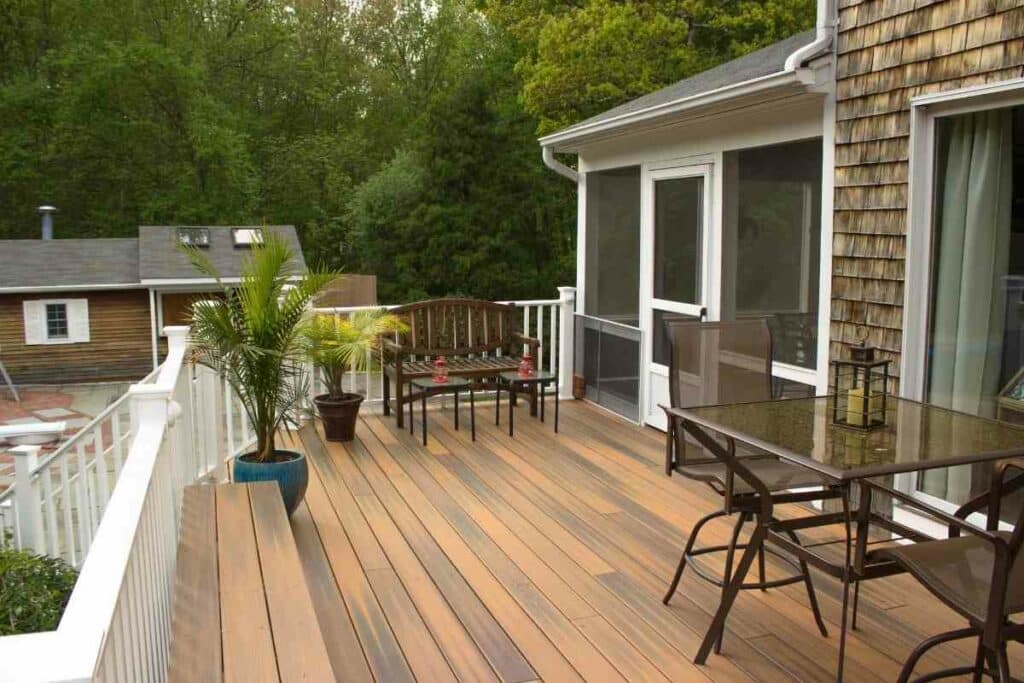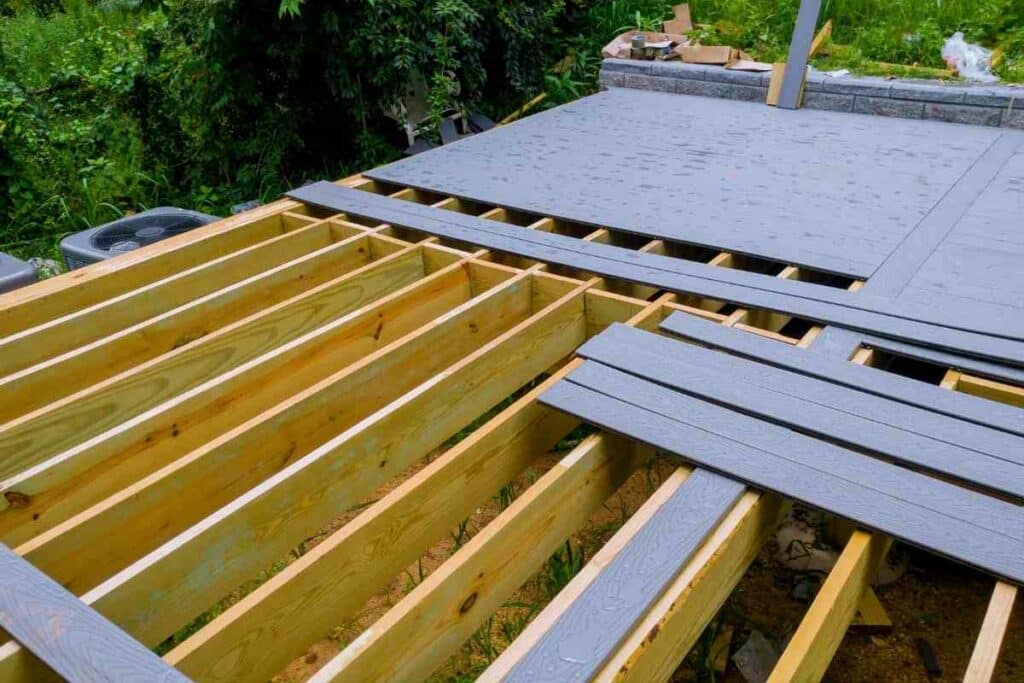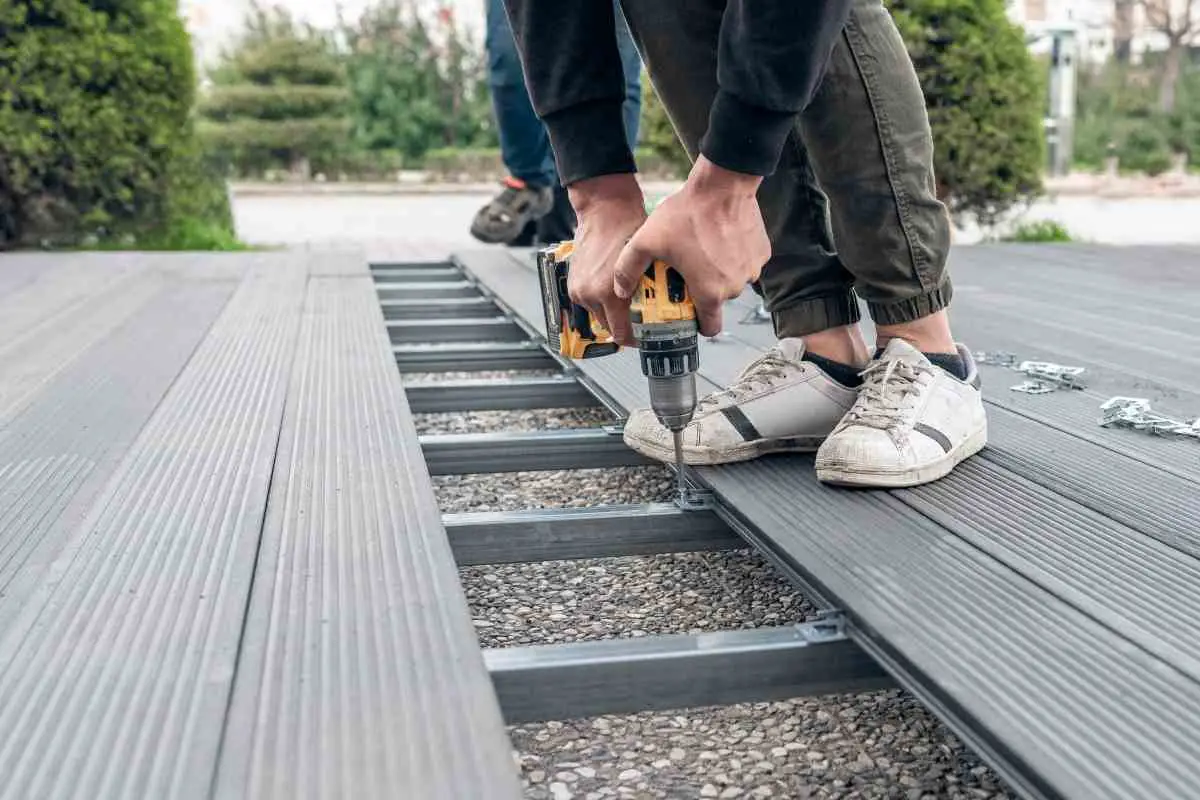Composite material offers better slip resistance than most decking materials but it can still become very slippery when it’s wet.
In fact, it becomes even more dangerous than other decking materials, such as wood decking, when it’s slippery.
A slippery composite deck poses a serious safety risk and it’s important to solve this problem to avoid unwanted falls and slips.
In this article, we’ll discuss some effective ways that you can use to make your decking less slippery.
What Makes Composite Decks Slippery?
The following are the most common reasons that can make your composite decking slippery.
Winter Season and Moisture
Whether you’re using composite or any other material, winter season moisture can make your decking slippery.
The accumulation of both water and ice on your decking can not only lead to falls and slips but can also damage your deck in the long run.
Mold and Algae
The growth of mildew, mold, algae, and moss is one of the most common reasons why composite decks become slippery.

As your decking is outside and exposed to environmental elements, it can become moist.
Additionally – It’ll also have debris and food particles, which creates a perfect condition for mildew, mold, algae, and moss to grow.
Debris
Debris such as falling leaves and dirt can also make your composite decking slippery.
During autumn, your decking will have a lot of leaves and they become slippery when rain falls on them.
Moist leaves can also start to decay on your decking, allowing bacteria and mold to grow.
It further increases the slipperiness and can also damage your decking if left unnoticed.
How to Make Composite Decking Less Slippery?
The following are some of the most effective ways you can use to make your composite deck less slippery.
Install Anti-Slip Tape
You can install high-quality anti-slip tape on your decking to improve its resistance and make it slip-free.
It’s a quick, easy, and cheap solution that allows you to get rid of a slippery deck within minutes.
Anti-slip tape offers excellent grip, just like sandpaper, and allows you to move easily on your deck.
Make sure that you clean your decking thoroughly before applying the tape so that it can stay in place.
The biggest advantage of using anti-slip tape is that it doesn’t raise your desk’s surface.
Additionally, it sticks to the decking material well and doesn’t come off easily, unlike ordinary tape.
Use Mold Cleaners
As mentioned, the buildup of mildew, mold, and algae can make your composite decking slippery, especially when they’re combined with moisture.
You’ll need to use a mold cleaner to remove these buildups from your decking to make it less slippery.
Apply the solution to your decking and rinse the entire surface using a mop or stiff bristled broom to remove these materials.
Apply Anti-Slip Coating
There are different types of anti-slip coatings that you can use on your composite decking to increase traction and resistance.
If you want to change the overall look of your decking, consider using non-slip paint.

Make sure that you clean your deck before applying the paint so that it can stick properly. Use a brush or roller to apply the paint and let it dry thoroughly.
It’ll provide you with a great finish that’ll prevent slipperiness as well.
If you don’t want to change the appearance of your deck, consider using a mixture of sealer and sand.
From Experience – Mix sand and sealer with a 4-to-1 ratio and apply it to your deck. Once it dries, add another coat to the decking to ensure that sand does its job effectively.
Use Anti-slip Strips
Applying paint or sealer to your composite decking can be a time-consuming task.
If you have a busy daily routine, consider using anti-slip stripes.
They’re made of hard plastic and have a textured design on top that makes them slip-resistant. You can also install anti-slip strips on your deck steps to make them slip-free.
Most anti-slip strips come with a screw-in design and you need to attach them to your deck boards using screws.
It means that they’ll be installed on your deck permanently. Additionally, they also raise the surface of your deck, which can present a tripping hazard.
Place Slip Resistant Mats
Adding anti-slip inserts or mats to your composite deck is an effective way to make it less slippery.
The best thing about this solution is that you won’t need to make any permanent changes to your deck.
You only need to place them on your deck boards and they’ll stay in place by sticking into the grooves and creases.
You can use slip resistance mats to cover your entire deck to make it slip-free.
The only downside of this solution is that it can hold moisture against your composite decking, which can damage them over time.
To prevent this problem from occurring, you’ll need to remove these mats when you’re not using your deck.
Apply Waterproof Coating
As mentioned, the accumulation of moisture is one of the biggest reasons why your decking becomes slippery.
Not only does it pose a safety risk but it can also damage your composite decking.
One of the best ways to solve this problem is to use a waterproof coating and cover your entire deck.
It’ll prevent moisture from accumulating and make your deck less slippery.
It’s easy to apply a waterproof coating to your deck.
You’ll need to use a roller or brush that you need to use while applying any other type of paint or coating.
Don’t forget to clean your composite decking before applying the coating. Additionally, let the paint dry thoroughly before you start using the deck.
The only downside of this solution is that the waterproof coating deteriorates with time.
You’ll need to reapply it after two to three years to keep your deck slip-free and waterproof.
Install Slip-Resistant Composite Decking
If your current composite deck is on its last legs, you might be planning to get new decking installed.
In such a scenario, we recommend you go with slip-resistant composite decking.
It’s a specially designed type of decking that will eliminate the need for using different methods to make your decking less slippery.
The best thing about slip-resistant composite decking is that it can resist insect attacks and fungal growth.
Tips to Prevent Deck from Getting Slippery
After making your composite decking less slippery, you’ll need to make sure that it stays that way.
Using the following tips will help you maintain and keep your composite decking less slippery.
Keep Your Decking Clean
Just like you clean your home every day to remove dirt and debris, you’ll need to clean your deck regularly as well.
You want to make sure that you remove leaves and dirt from your decking so that they don’t trap in moisture.
It’ll keep your deck from becoming the breeding ground for mildew, mold, moss, and algae.
You’ll only need to spend a few minutes removing loose debris and leaves from your deck using a broom.
You can also clean your decking with a mixture of mild detergent and hot water once every two months for deep cleaning purposes. It’ll also help keep it clean and avoid a slippery mess.
Improve Drainage
Making sure that your deck surface is draining properly is also critically important to keep it slip-free.
You’ll notice that there are small gaps between your composite decking boards. These gaps are left to allow for contraction and expansion of boards with the temperature change.

These gaps also allow moisture and water to drain out properly.
But these gaps can get blocked with debris and dirt with time, especially if you don’t clean your decking regularly.
It prevents water from draining out and you end up with pooled water, making your deck surface slippery.
You’ll need to clean these gaps every time you clean the decking so that they don’t get blocked. You can use an old knife or any other pointy tool to remove dirt from these gaps.
Remove Snow and Ice
Your composite decking can become slippery at any time of the year.
However, this problem most commonly occurs during the winter season because of the snow and ice buildup on the deck.
While ice can make any type of decking slippery, it affects composite decking more than other materials such as natural wood.
You’ll need to use a shovel to remove snow and ice buildup from your decking to keep them from accumulating.
Be Careful – Keep in mind that ice forms under the soft snow. If you remove the snow after every snowfall, the risk of ice forming on your deck will minimize.
Final Words
Slippery decking can be extremely dangerous as it can lead to unwanted accidents.
It usually happens during winters because of the buildup of moisture, debris, and snow on the decking.
We hope this guide will help you understand how to make your decking less slippery.
Make sure that you use the tips listed in this guide to keep your composite decking clean and prevent it from becoming slippery again.
